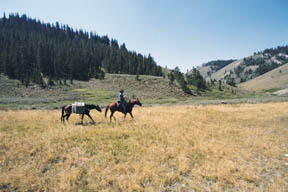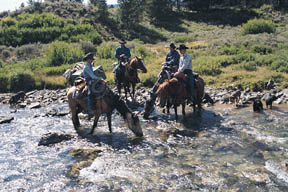Riding tall in the saddle and deep in the high country, rancher
Dan Ingalls is the picture of a contented man. Central Wyoming,
he says, is the finest place to winter cattle he’s ever seen–a
regular banana belt compared to his native South Dakota. And his
Bacon Creek grazing allotment in the Bridger-Teton National Forest
is his idea of an ideal summer range–that is, it was until the
grizzly bears moved in.
“Ten years ago, we had no problems with bears,” he says. “We had
a black bear once in a while, and once in a while you’d find a
critter that you knew had been killed by a bear. But it was something
rare. There were years when I never lost a cow to bears.”
Such was not the case in the summer of 1999. That’s the year Ingalls
lost 114 calves and 37 cows to Ursus arctos horribilis. The aggrieved
rancher submitted a damage claim to the Wyoming Game & Fish Commission
in the amount of $908,845–a figure the commissioners feel is way
too high. Normally, ranchers are only reimbursed for “confirmed
kills,” multiplied by a factor of l.67. Moreover, the commission
doesn’t acknowledge lifetime losses; i.e., the $620,000 the Riverton
rancher figures he’s not going to make, thanks to the loss of
so many registered calves and young cows.
Ingalls didn’t get the money, but he has managed to draw some
attention to what he views as a serious and growing threat facing
ranchers in the vicinity of Yellowstone and Grand Teton national
parks, where the grizzly bear enjoys federal protection. But as
the bears continue to increase in number and spread outward into
adjoining national forest lands, he wonders whether they should
continue to be accorded preferential treatment. And how many bears
on public lands are too many bears?
“He’s trying to make the government agencies accountable,” declares
friend and fellow rancher Lois Herbst. “No one has ever forced
the issue, I think, like Dan has. He’s had people who helped him
find maps showing whether or not we’re in a certain type of zone–you
know, recovery zone. He’ll write letters asking them for information,
and he expects an answer. But he usually doesn’t get an answer
until after it would have been of help to him.”
“The problem with this whole thing, I think, is the guidelines,”
adds Ingalls. “The Interagency Grizzly Bear Guidelines.
Dan whips out one of several Forest Service documents he’s managed
to obtain through dogged persistence: the so-called “Greater Yellowstone
Ecosystem Grizzly Bear Situations” map. Portions of the map surrounding
Yellowstone National Park are colored yellow, orange and red–areas
where the grizzly is permitted to run free, reproduce and exercise
dominion over all creatures great and small. National forest lands
outside of the yellow, orange and red recovery zones are colored
green and designated Situation 5, wherein “any grizzly involved
in a human-grizzly conflict will be controlled.” The guidelines
glossary goes on to describe a human-grizzly conflict as “a confrontation
between man and/or his property and the bears in which the safety
of the man and/or the bear is jeopardized and/or property loss
occurs.
|
|
|
|
Given the fact his Bacon Creek grazing allotment is colored green,
and presuming cattle would fall under the definition of property,
Ingalls feels he has a pretty good ”case against the grizzly bear.
As for “safety of the man,” Dan recounts a frantic cell phone
message he received in August 1999 from his youngest sons Samuel
and Spencer–who at the time were manning the cow camp.
“It was a little scratchy, but I heard ’em say, “Dad, we’ve seen
five grizzly bears in camp this morning. While we’re talkin’ to
you, right now, we see five grizzly bears!’”
Dan did some digging and discovered that wildlife biologists working
for the Wyoming Game and Fish Commission had been conducting “research
trapping” in the vicinity of his cow camp. He produces another
map, one peppered with large black dots indicating where the traps
were set, and smaller black dots indicating where dead cattle
were found. Curiously, the big dots appear to attract the little
dots. Is there a connection? Dan Ingalls believes so.
“The Game and Fish says there’s no correlation between their research
baiting and my cattle losses,” he says. “The only thing they’re
showing [on the map] are confirmed kills, and look at that. Big
dots are the research traps, the little dots are the kills. It’s
what pulled bears to the area to begin with–and not just bears
but problem bears. The problem bears teach the other bears how
to kill. And how to eat beef.”
Problem bears are routinely collared by government trappers and
taken for a ride back to Yellowstone. But according to Ingalls,
Yellowstone Park officials already have more grizzlies than they
know what to do with. So the bears go on shorter rides, and are
back in no time–especially if there happens to be the odor of
dead meat hanging in the air.
“See, when they go out here and they start setting up a lot of
stinky baits, they’re pulling bears out of the recovery area.
Why? If they get too many bears in the recovery area, they’ve
gotta delist. But if they get ’em scattered around out here, they
can say, ‘Well’....”
Ingalls concedes he might just be the victim of a series of tactical
blunders. More likely, he insists, government agents have been
plotting behind closed doors to enlarge the recovery zone in order
to accommodate the burgeoning bear population–and also to appease
grizzly bear proponents, who in the Jackson Hole area outnumber
ranchers 10-to-1. Indeed, many stock growers maintain the Endangered
Species Act of 1973 is part of a plot to drive ranchers off public
lands and turn them into “willing sellers.”
“It’s called the Wildlands Project, Wildlands Recovery, or Wild
Again,” says Lois Herbst. “They give it different names. It speaks
about using the grizzly bears, the wolves and the lynx–the Canadian
lynx–to end multiple use on the public lands. They want to make
these lands wild again, and the states that have so much public
land are the ones being hit the hardest, because they know they
can get rid of us.”
What is ironic about the ongoing feud between ranchers and nature
lovers is that no one spends more time communing with mother nature
than Dan Ingalls and his sons. Since virtually all of their 100-square-mile
grazing allotment is accessible only by horseback, they manage
for days on end without electric lights, indoor plumbing, television,
or radio. Were it not for their walkie-talkies, cell phone, and
global positioning transponder, they might just as well be living
in the middle of the 19th century. They are in fact close kin
to the pioneers–descendants of the same Ingalls clan whose adventures
are chronicled in the book “Little House on the Prairie.” (Dan’s
great-great-grandfather was first cousin to Charles Ingalls, father
of writer Laura Ingalls Wilder.)
Growing up on a cattle ranch in rural South Dakota, Dan learned early the virtues of hard work. He has instilled these virtues in his six sons, all of whom are active partners in Dan Ingalls & Sons of Riverton, which specializes in Angus cattle “specifically bred to prosper in high altitude areas.” Also, good-natured but fearless Catahoula herding dogs dutifully accompany the boys whenever they ride out of camp. Dan doesn’t miss the brutal Black Hills winters of his boyhood; however, he does miss the amiable relationship he and his family enjoyed with the game and fish folks there. “I mean, we didn’t agree with everything they stood for and said and did–but, we worked with them. We weren’t anti-wildlife; we were pro-wildlife. I can remember the first fox I saw. I can remember the first prairie deer I saw. Lots of animals through the years.”
In South Dakota, he says, the Ingalls family worked hand-in-hand
with the wildlife people to establish and maintain habitat for
deer and fish. “We didn’t charge for hunters. Typically, on our
place we took two or three days off and guided hunters–hauled
them around, picked them up, charged ’em nothing. The point I’m
trying to make is, I was amazed when I came here, to this state,
and found the anti-agriculture people in the Game & Fish. I can’t
believe it!”
Ingalls doesn’t see any good reason why he as a cattleman should
have to be at odds with the wildlife people–or with the environmentalists,
for that matter. Indeed, he looks forward to the occasional close
encounter with a backpacker in the backwoods.
“We’ve invited them to stay with us,” he says, “and struck up
some friendships. We try to be friendly with everyone. You know,
you can see guys coming down the trail and they’re from some out-of-state
place. They’ve waited all year and saved all year to do this,
and they’re excited. They’ll talk about how beautiful it is up
here, and they’ll ask, ‘What do you do?’ ‘Well, we run cattle,
and we’re riding on it.’
“But almost all of ’em, when you talk about the beauty of the
country, how nice it is and how untouched it is, they all ask
you a form of the same question. Different words, same question:
‘How do you think it was before man came along and ruined it all?’
“I say, ‘Well, how was it? Who would know?’ Lewis and Clark would
know–read their journals. They ate their mules, because there
was no game. They found pockets of game when they did their survey,
and they saw tracks of predators. The bears were a big problem
to them–and wolves. But in their mind, they have a picture of
Utopia. In schoolbooks, in the news, on the Discovery Channel,
they have a picture in their minds that is not reality. That is,
that somehow there was all this game and all these predators that
all lived happily ever after until man came along and ruined it
all. That’s what’s in their minds, but it’s a false picture.”
The true picture, as Ingalls paints it, is that Bambi, Thumper,
Rocky, Bullwinkle and their friends won’t fare so well in the
presence of major predators. “The top of the food chain gets heavy
really fast,” he says. “And what we’ll see, if the wolf and grizzly
bear population is unchecked, their population explodes and everything
else declines. So when I talk to these people I say, ‘You’ve got
to choose. When you come up here and hike, do you want to see
elk in that meadow? Deer drinking from the creek? Or do you want
to see a few tracks of a few predators? You’ve gotta make a choice.
You cannot have it both ways.”
Richard Menzies is a frequent contributor to RANGE magazine and
also an occasional wide-eyed, out-of-state visitor to Wyoming.Body
text.
|
|
|



